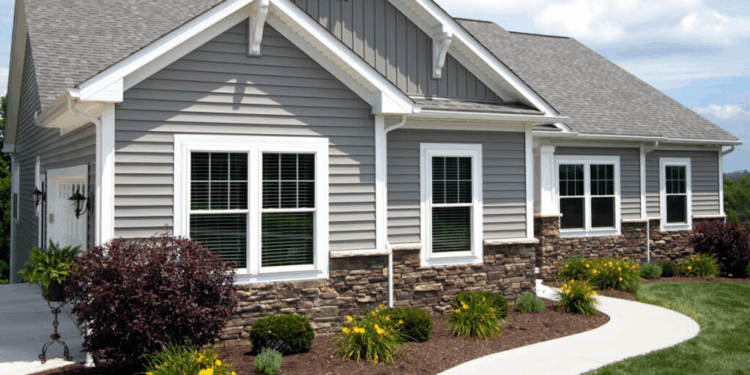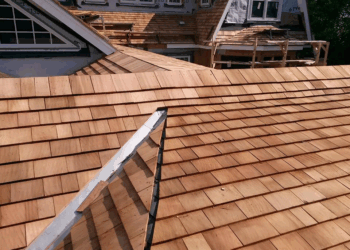
Composite home siding options offer homeowners a versatile array of choices to enhance the aesthetic and functionality of their residences. From durable materials to eco-friendly solutions, this comprehensive guide dives into the world of composite siding with detailed insights and expert recommendations.
Delve into the nuances of different siding options, learn about installation processes, weigh cost considerations, and understand the environmental impact of your choices. Get ready to transform your home with these innovative siding solutions.
Types of Composite Home Siding
Composite home siding offers a durable and low-maintenance alternative to traditional materials like wood or vinyl. There are several types of composite siding options available in the market, each with its own unique features and benefits.
Fiber Cement Siding
Fiber cement siding is a popular choice for homeowners looking for a durable and fire-resistant option. Made from a mixture of cement, sand, and cellulose fibers, this type of siding is known for its longevity and resistance to rot, insects, and harsh weather conditions.
It can mimic the look of wood or stucco, making it a versatile choice for various architectural styles.
Vinyl Composite Siding
Vinyl composite siding is an affordable and low-maintenance option that offers excellent durability and resistance to fading, cracking, and warping. It is available in a wide range of colors and textures, allowing homeowners to customize the look of their exterior.
Vinyl composite siding is also easy to install and clean, making it a popular choice for many households.
Engineered Wood Siding
Engineered wood siding combines wood fibers and resin to create a strong and durable material that closely resembles traditional wood siding. It offers the natural beauty of wood with enhanced durability and resistance to moisture, pests, and rot. Engineered wood siding is available in various styles, including lap, panel, and shake, providing homeowners with options to suit their aesthetic preferences.
Composite Stone Siding
Composite stone siding is a lightweight and cost-effective alternative to natural stone siding. Made from a mixture of stone particles and other materials, this type of siding offers the authentic look of stone without the high cost and heavy weight.
Composite stone siding is durable, weather-resistant, and easy to maintain, making it a practical choice for homeowners seeking a luxurious exterior finish.
Installation Process
When it comes to installing composite home siding, it is important to follow a step-by-step process to ensure a successful outcome. This type of siding offers durability, low maintenance, and aesthetic appeal, making it a popular choice among homeowners. Below is a general guide on how to install composite siding on a home, along with the tools and materials required for the job.
Step-by-Step Guide
- Prepare the Surface: Ensure that the surface where the siding will be installed is clean, smooth, and free of any debris or obstacles.
- Measure and Cut: Take accurate measurements of the area to be covered and cut the siding panels accordingly, allowing for proper fit.
- Install Starter Strip: Begin by installing a starter strip at the bottom of the wall to provide a secure base for the siding panels.
- Attach Siding Panels: Place the siding panels one by one, starting from the bottom and working your way up, ensuring they are level and securely fastened.
- Overlap Joints: Make sure to overlap the joints between panels according to manufacturer guidelines to prevent water infiltration.
- Finish with Trim: Complete the installation by adding trim pieces around windows, doors, and corners for a polished look.
Tools and Materials Required
- Composite Siding Panels
- Starter Strip
- Nails or Screws
- Tape Measure
- Level
- Saw (for cutting)
- Hammer or Screwdriver
- Trim Pieces
- Caulk and Caulking Gun
- Safety Gear (gloves, goggles, etc.)
Cost Considerations
When considering composite home siding options, it is essential to factor in the cost implications to make an informed decision that suits your budget and long-term goals. By comparing the initial cost with the potential long-term savings and additional expenses related to maintenance or repairs, you can determine the most cost-effective choice for your home.
Initial Cost vs. Long-Term Savings
- Composite siding materials may have a higher initial cost compared to traditional options like wood or vinyl. However, the durability and low maintenance requirements of composite siding can result in long-term savings by reducing the need for frequent repairs or replacements.
- Consider the lifespan of different types of composite siding and calculate the overall cost over the years to determine the most cost-effective option for your home.
Maintenance and Repair Expenses
- While composite siding is known for its durability and resistance to rot, pests, and moisture, there may still be additional expenses related to maintenance over time.
- Regular cleaning, inspections, and minor repairs may be necessary to ensure the longevity and appearance of your composite siding, which should be factored into your overall cost considerations.
Environmental Impact
When it comes to the environmental impact of composite home siding materials, it’s essential to consider the eco-friendliness and sustainability of these products. Composite siding options offer several benefits that contribute to sustainable building practices, making them a popular choice among environmentally-conscious homeowners.
Eco-Friendliness
Composite home siding materials are often made from recycled materials, such as wood fibers and plastics, reducing the demand for virgin materials and diverting waste from landfills. This recycling process helps to conserve natural resources and reduce the carbon footprint associated with traditional siding materials.
Recyclability
One of the key advantages of composite siding products is their recyclability. At the end of their lifespan, these materials can be recycled and used to create new products, reducing the amount of waste generated and promoting a circular economy.
This reusability makes composite siding a more sustainable option compared to non-recyclable materials.
Energy Efficiency
Composite home siding options are designed to be energy-efficient, helping to improve the overall thermal performance of a building. By reducing heat loss and air infiltration, composite siding can enhance the energy efficiency of a home, leading to lower heating and cooling costs.
This energy-saving feature not only benefits homeowners but also helps to reduce the environmental impact associated with energy consumption.
Epilogue
As we conclude our exploration of composite home siding options, remember that the right choice can elevate your home’s appearance, increase sustainability, and potentially save you money in the long run. Make an informed decision to create a lasting impact on your property’s value and environmental footprint.
Expert Answers
What are the main types of composite home siding?
Common types include wood-plastic composite, fiber cement, and engineered wood siding.
How do composite siding materials contribute to sustainability?
Composite siding is often made from recycled materials and is energy-efficient, reducing environmental impact.
What tools are typically needed for installing composite siding?
Basic tools like a saw, hammer, level, and tape measure are essential for a successful installation.














